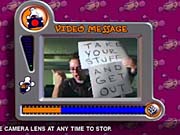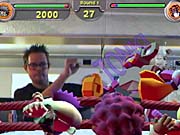While it's usually pretty easy to pigeonhole video games into neat little categories, Sony's EyeToy: Play is completely different from anything else out on the market. On one side of the coin, this collection of party-oriented minigames finds a home near games like the Mario Party series, partly because you can pick it right up and play with any number of friends. But it can also be said that it falls squarely in between games like Samba De Amigo or Dance Dance Revolution, because of its reliance on a peripheral--though the huge difference with EyeToy is that you interact with the game by way of a small video camera. As is the case with most party games, EyeToy is simplistic at best, but the way you play the game truly makes it a one-of-a-kind experience that just about anyone, regardless of skill, can enjoy.

Developed by Sony's London Studio, EyeToy: Play is, at its core, a collection of various minigames that have you standing in front of the camera and your television, waving your arms or moving your entire body to play. These games include basic challenges of rhythm, sports-oriented challenges, and games that require you to hit moving targets that fly onscreen. For example, in the Kung Foo game, you are positioned squarely in the middle of the screen and are tasked with swatting away ninjas that fly at you from all directions. Soccer Craze tasks you with keeping a soccer ball from hitting the ground by hitting it from below with your head. Disco Stars finds you copying the motions of an onscreen character. There are 12 games in all to test your agility and hand-eye coordination, and the variations between them are slight. While it might seem as if there's not much variety to keep your interest for long, the main draw for the game is simply how you play it, since this type of interaction has never been seen before. Given that EyeToy: Play is meant to appeal to people of all ages, and to those with little or no gaming skill, you should not expect these games to require much thinking to play them. In this respect, EyeToy: Play excels in its simplicity.
In addition to the main portion of the game, there are two other fairly interesting modes: playroom and video messaging. The first of these, playroom, is perfect for a party atmosphere. It simply places the video being recorded by the camera on the television with a variety of different video effects like motion blur and delay, and it also creates sound according to movement. There are also settings that place superimposed graphics, such as snow or a lively fish tank, over the video, so you can turn it on for atmosphere when you have guests over. The second additional feature is video messaging, which allows you to record short video clips with sound and store them on your memory card for later viewing. An empty memory card can store up to sixty seconds of video. In all, these additional features add a great extra touch to EyeToy: Play, making an already interesting and innovative product all the more attractive.
As previously mentioned, EyeToy: Play makes exclusive use of a video camera--in fact, the standard PlayStation 2 controller is not even used with the game. You place the camera on top of your television and aim it toward the person playing the game. After you plug the camera into one of the USB ports on the front of your PlayStation 2, playing the game and navigating through menus are handled by your own movements in front of the television. To effectively play the game, you'll need to make sure that you've got adequate room and distance from your television to properly frame yourself in the picture, which may require you to move furniture. You'll also have to take lighting into account, because if your room is too dark, your movements simply won't register properly. If you can't provide enough light, the game has settings to allow you to compensate for having a room that is too dark.

Visually, EyeToy: Play sports a bright, cartoony look with smooth animation for the graphics that make up the general gameplay experience. While these sorts of graphics are usually the most attractive part of a video game, in EyeToy: Play, they're really only a small part of the equation. The video recorded by the camera is peppered with all sorts of effects to spice up the visuals. While the EyeToy camera does a decent job, it certainly isn't the greatest in terms of video quality--the image that is actually displayed on the screen is usually somewhat blocky and blurry even when focused. If you've ever seen the video recorded by a standard webcam, that should give you a pretty good idea of the quality you can expect from the camera. Another small gripe comes with the game's use of short music loops, which make up the bulk of the music that you hear within the game. Given that most of the games last for just a few short minutes, it doesn't create that much of a negative impact, but it sure would have been nice to listen to an entire song instead of a simple repeating loop over and over again. On the upside, most of the sound effects are superb and add a great deal to the interactive nature of the game--for instance, you're given an auditory clue when you successfully make contact with something, as a subtle way of letting you know you're playing the minigames correctly. In short, a great deal of work was put into making EyeToy: Play an immersive experience above everything else, and it certainly shows.
If you're in the market for a game to play when you have friends over, especially friends who have little or no interest in video games, EyeToy: Play is an excellent choice. It's incredibly easy and fun to play, and it's hard to stop playing once you've gotten everyone in the room involved. As a single-player game, though, the minigames don't provide much of a challenge. While only time will tell if more games will use the EyeToy camera in the future, the first game to make use of it is one that will provide at least some fun for just about everyone.